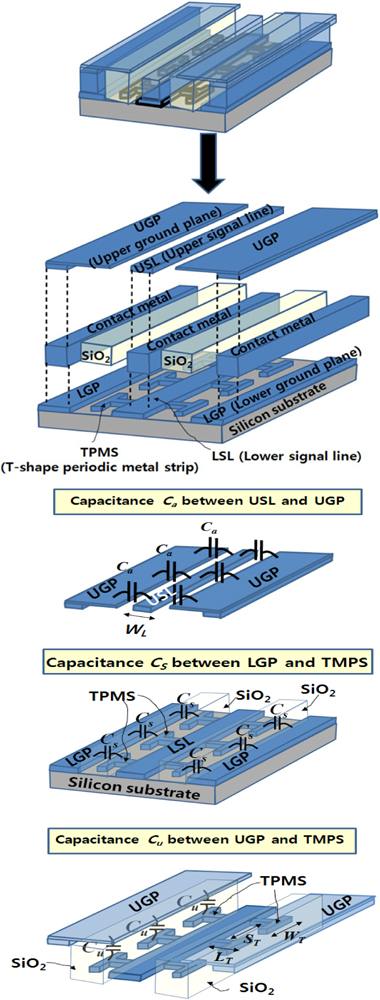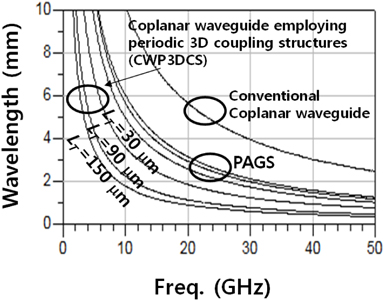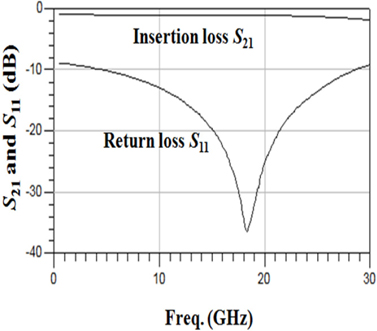



For a miniaturization of wireless communication systems, onchip RF passive components should be realized on semiconducting substrates [1-3]. Until now, passive components employing conventional transmission lines have been fabricated outside of ICs due to their large sizes [4-12]. In order to solve this problem, transmission lines employing slow-wave structure have been developed [1-9]. Of all slow-wave structures, the coplanar waveguide employing periodically arrayed ground strip (PAGS) showed a much shorter wavelength compared with conventional coplanar waveguides [1-3]. At 10 GHz, the wavelength of the PAGS was 4.95 mm, which is 48.5% of conventional transmission line on silicon substrates [1-3]. However, this values is still too large for an integration of passive components on silicon substrate. For example, if an impedance transformer employing PAGS with an operation frequency of 10 GHz is fabricated on silicon substrate, its length is 1.24 mm, which is too long for an integration on silicon substrates. Therefore, integration of passive components on silicon substrates requires further reduction of wavelength [1-3].
In this work, in order to realize a further reduction of wavelength, we developed a coplanar waveguide employing periodic 3D coupling structures (CWP3DCS) on silicon substrates. Of all slow-wave structures that have been reported to date, the CWP3DCS structure shows the shortest wavelength, being only 17.3% of conventional coplanar waveguides and only 35.6% of the transmission line employing PAGS structure. Using the CWP3DCS, a highly miniaturized on-chip impedance transformer was developed on a silicon substrate. The size of the impedance transformer employing the CWP3DCS on silicon substrate was 0.04 mm2, which was only 0.74% of conventional designs fabricated on silicon substrates.
2. A NOVEL COPLANAR WAVEGUIDE EMPLOYING PERIODIC 3D COUPLING STRUCTURES ON SILICON SUBSTRATE
Figure 1 shows the schematic design of CWP3DCS, showing comb-type lines on the silicon substrate. The fabrication process is described as follows. For the purpose of forming lower ground planes (LGP), lower signal line (LSL) and T-shape periodic metal strips (TPMS), a Ti/Au bilayer was deposited on silicon substrate by evaporation, then the contact metal was deposited by gold electroplating in a thick photoresist mold. After the formation of contact metal, 1 μm-thick SiO2 layer was deposited. Finally, Au was deposited to form the upper ground plane (UGP) and upper signal line (USL).
The comb-type line consists of LSL and TPMSs, and the TPMSs are connected to the both sides of the LSL. The LGPs are placed on both sides of the comb-type line. USL and UGP exist on the top side of the novel coplanar waveguide structure. The USL is electrically connected to LSL through the contact metal, while UGP is electrically connected to LGP. The SiO2 film is placed between UGP and TPMS. Conventional coplanar waveguide has only a periodical capacitance
Figure 2 shows the wavelength of transmission lines on silicon substrate, showing wavelength (
3. A HIGHLY MINIATURIZED IMPEDANCE TRANSFORMER EMPLOYING THE CWP3DCS
Using the CWP3DCS, an on-chip impedance transformer was fabricated on silicon substrate. Figure 3 shows a photograph of the
Measured return loss
The impedance transformer showed the operation band of DC - 30 GHz. This result (DC - 30 GHz) is only a bandwidth for application to an impedance transformer. However, the actual bandwidth is a passband when the proposed structure is used for application to transmission line Therefore, using transmission line theory [13], we extracted the actual bandwidth of the CWP3DCS using the proposed structure in Figure 1 to theoretically characterize use of a simple equivalent shunt circuit [13]. According to the results, we can obtain the following passband equation:
In the above equation,
We developed a short wavelength CWP3DCS on a silicon substrate. This CWP3DCS showed the shortest wavelength of all silicon-based transmission line structures that have been reported to date, which was only 17.3% of the wavelength of a conventional coplanar waveguide on silicon substrate. We fabricated a highly miniaturized impedance transformer employing the CWP3DCS on silicon substrate. The impedance transformer showed return loss values better than -10 dB in a broad band from 4.6 GHz to 28.6 GHz, and insertion loss values better than -1.3 dB in the same frequency range. The size of the transformer was 0.04 mm2, which was 0.74 % of the size of the transformer employing conventional coplanar waveguide on silicon substrate.







